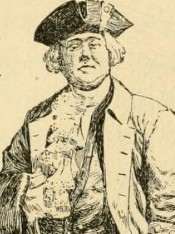
Back جيورجى ماثيوس ARZ George Mathews (Politiker) German George Mathews Spanish ג'ורג' מתיוס HE George Mathews Italian
George Mathews | |
|---|---|
 1896 illustration of George Mathews.[1] | |
| Governor of Georgia | |
| In office November 7, 1793 – January 15, 1796 | |
| Preceded by | Edward Telfair |
| Succeeded by | Jared Irwin |
| Member of the U. S. House of Representatives from Georgia's 3rd district | |
| In office March 4, 1789 – March 3, 1791 | |
| Preceded by | Position established |
| Succeeded by | Francis Willis |
| Governor of Georgia | |
| In office January 9, 1787 – January 26, 1788 | |
| Preceded by | Edward Telfair |
| Succeeded by | George Handley |
| Georgia General Assembly | |
| Virginia House of Burgesses | |
| In office Did not convene | |
| Preceded by | Charles Lewis |
| Succeeded by | Position abolished |
| Personal details | |
| Born | August 30, 1739 Augusta County, Virginia Colony, British America |
| Died | August 30, 1812 (aged 73) Augusta, Georgia, U.S. |
| Resting place | St. Paul's Episcopal Church Cemetery |
| Political party | Federalist |
| Spouses |
|
| Relations | Mathews family |
| Residence(s) | Goose Pond Plantation, Wilkes County, Georgia |
| Profession | Planter, politician |
| Signature | |
| Military service | |
| Allegiance | |
| Branch/service | Virginia militia Continental Army United States Army |
| Years of service | Militia: 1774 Continental Army: 1775–1783 U.S. Army: 1810–1812 |
| Rank | |
| Battles/wars | |
George Mathews (August 30, 1739 – August 30, 1812) was an American soldier and politician from the U.S. States of Virginia and Georgia. He was a brevet brigadier general in the Continental Army, the 20th and 24th Governor of Georgia, a U.S. Representative from Georgia, and the leading participant in the Patriot War of East Florida.
Born in Augusta County in the Virginia Colony, Mathews was in early life a merchant and planter. As an officer in the colonial militia, he gained statewide fame for his role in the Battle of Point Pleasant of Dunmore's War. He was afterward elected to the House of Burgesses from Augusta County, but did not attend a session. On the outbreak of the American Revolutionary War, he served as colonel of the 9th Virginia Regiment in the Continental Army. He and his entire regiment were captured on October 4, 1777, in the Battle of Germantown. Mathews spent the next four years as a prisoner of war, including two years on a British prison ship. He was brevetted brigadier general at the end of the war.
After the war, Mathews moved to the state of Georgia and was quickly elected governor of the state. He served two nonconsecutive terms, voted to ratify the United States Constitution, and served in the 1st United States Congress. His second term as governor was overshadowed by his involvement in the Yazoo Land Fraud, which led to his political downfall.
Mathews relocated to the Mississippi Territory and in 1810 was sent as a secret agent by President James Madison to annex the Spanish territory of East Florida for the United States. Mathews was unable to claim the territory peacefully, so he created an insurrectionist force that captured Ferninanda Beach and Amelia Island and turned them over to the U.S. This act, now referred to as the Patriot War of East Florida, was denounced by Spain and its allies. Madison, under political pressure, disavowed Mathews's actions. The vagueness of Madison's instructions to Mathews have led to significant debate among historians as to whether Mathews acted outside of the purview of his mandate.
- ^ Harris, Joel Chandler (1896). Stories of Georgia. New York: American Book Company. p. 141. ISBN 9780871520821.